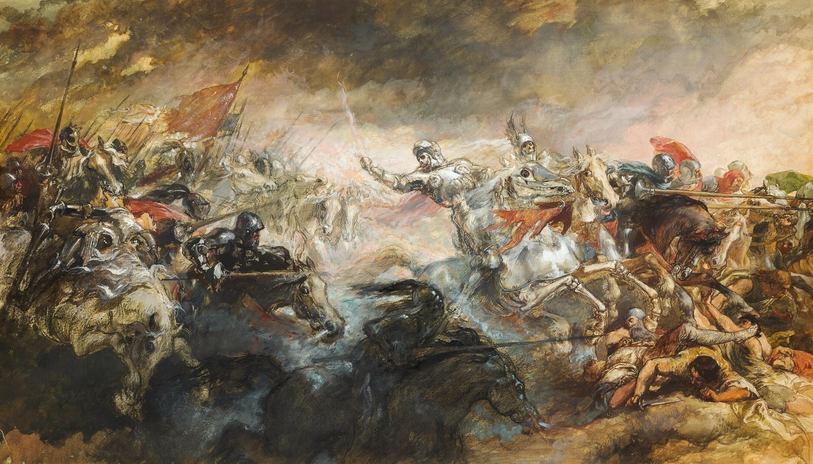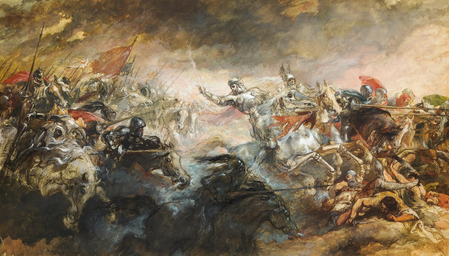Edited by: Madhumitha Arivu Chelvan
OPINION
Bullets, blood, and mass destruction be it on-screen, or paper has been often portrayed with romantic notions. There is an inexplicable level of courage felt via the protagonist, shooting across enemy lines. When this feeling of courage is morphed with patriotism and garnished by the gloriousness of victory, the audience begins to justify war. Justice, being served to the cruel-minded antagonist, avenging our hero’s soul, makes us feel at peace. Revenge is a silly feeling at best, extenuating the blood on our hands.
The portrayal of violence in cultural mediums has always been a subject of controversy. An example is when Marinetti let his fascist ideas percolate into his literary works, which led to the rise of the Italian Futurists. The futurism movement began in 1909, and painters like Gino Severini who glorified war through their paintings joined Marinetti. Is it coincidental that merely a few years before World War I, The Manifesto of Futurism written by Marinetti proclaimed war as ‘the world’s only hygiene’?
In the past few decades, on-screen violence as a result of wars has gained momentum. Movies like Saving Private Ryan, Das Boot, and closer to home, Rangoon and Uri: The Surgical Strike, all set in different years, are alike in their glorification – or even justification – of shooting out an entire army of men. Such movies are often great retellings of real events or are about a fictional story based on the events’ background. What might be alarming is the allowance of such gory details of violence in mainstream media, which runs in parallel with the themes of courage and bravery.
On the other hand, Schindler’s List, a gem of a movie goes to show the effects of war in an unbiased manner. Steven Spielberg does not exaggerate about the benefits of war; instead, he focused on the loss of humanity as its consequence. Recently, Netflix US brought Nickelodeon’s The Legend of Korra for its viewers. Through a fascinating storyline depicting the tyrannical reign of the ‘Earth Empire,’ the creators have underlined the aestheticization of war in the real world.
Another instance of on-screen culture that has long since been ascertained as disturbing is the gaming culture. Treyarch’s Call of Duty: World at War and Tencent’s PUBG are two relevant examples. Recently, Tencent did a commendable job of bringing video games to mobile devices with its PUBG app. This is a good business move on their part, but its easy accessibility for young children possessing smartphones may pose a problem. Although various studies in recent years have proven that gaming and violent behaviour are in no way linked, there are other negative implications worth noting. The gaming experience might entice a fraction of the players, who’re too young to understand the consequences of war. Even if the child currently has no tendency to support any aspect of war, the exhilaration of the supposed battle mode might stay in their subconscious mind. Considering the percentage of the under 18 population that engages in such kind of gaming, this is worrisome.
If we were to glance at Wilfred Owens’ poem, Dulce et Decorum est, a feeling of nausea and pain would be expected. Wilfred paints a horrifying picture of his fellow soldier succumbing to chlorine gas and his defiled body being mercilessly carried away. He ends the poem with the following words:
“The old Lie: Dulce et decorum est
Pro patria mori.”
In simpler terms, Owens says that it is not sweet and befitting to die for one’s country. Wilfred wrote more poems that were similar, as an answer to pro-war writers like Jessie Pope, who would encourage the youth to fight for their nation and in death find glory. Alongside Owen, Siegfried Sassoon, Edmund Blunden, Robert Graves, and Richard Aldington, also wrote poems recounting their haunting memories of war.
Soldiers indeed have a hard time recuperating after leaving service. The internet is filled with personal accounts of men in service and the amount of trauma they are forced to suppress. Saving Private Ryan’s first act, showed a distressed Tom Hanks looking around at the bloodied waters and lifeless bodies floating about, capturing this haunting emotion perfectly. Daniel Carciones’ article on Webster Journal underlines some of the problematic areas of joining the army. Soldiers are taught from the very beginning that seeking help makes them weak, especially in the combat arms of the military, like infantry and artillery. Hence, a significant percentage does not even bother to address their mental health issues.
‘Aestheticization of politics’ as coined by Walter Benjamin is a crucial way of operation for fascists to promote their agenda. Fascist ideals of war can, quite subtly, seep into the creative media. As the consumer is unknowingly immersed into a culture seeded by pro-violence propaganda, they are liable to become supporters. Such is its power that during World War II, even fashion industrialists like Hugo Boss blurred the lines between creative liberty and fascist propaganda. The directors of the Boss company almost religiously followed Nazism. It’s somewhat confusing how censor boards find the expression of one’s sexuality as unappealing but promotion of war acceptable. As the amount of violence increases every day, the cultural representation of war is in dire need to undergo a paradigm shift.



